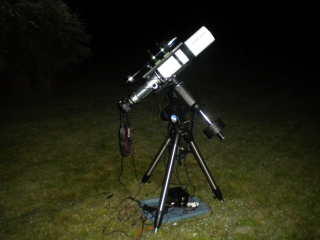Astrophotography and electron cryo-microscopy have much in common: In both cases, the objective is to take an image of a very dim object (dim = low-dose in the case of cryo-EM) with an optical instrument. Furthermore, the object tends to move while images are recorded. Finally, to see more detail of the object and suppress noise, images are averaged in both techniques. Below is a selection of images taken by Niko Grigorieff. Click on an image to see it at higher resolution. Details about the gear used can be found here.
The following images where taken in 2011/2012 on Mount Laguna (near San Diego), California (USA) using a QSI 583wsg camera.
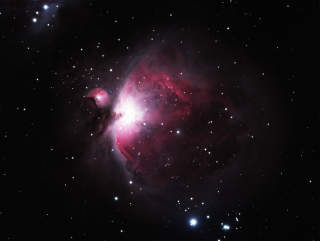 |
M42 (Orion Nebula)
Type: Emission & reflection nebula
Distance from earth: 1,300 light years
Constellation: Orion
Brightness (magnitude): 4.0
Stars are constantly born in the Orion nebula, the closest star nursery to earth.
|
NGC7635 (Bubble Nebula)
Type: Emission nebula
Distance from earth: 11,000 light years
Constellation: Cassiopeia
Brightness (magnitude): 10
The "bubble" is created by the solar wind from a hot central star (visible inside the bubble) which is about 20 more massive than our sun. The bubble is about 7 light years across and glows due to fluorescence excited by the intense ultarviolet star light.
|
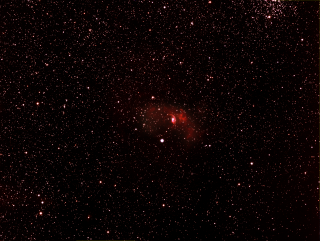 |
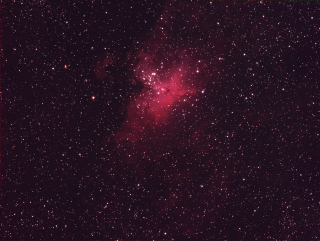 |
IC 4703 (Eagle Nebula)
Type: Emission nebula
Distance from earth: 6,500 light years
Constellation: Serpens
Brightness (magnitude): 6.0
The gas in this nebula is excited by the intense light of the M16 star cluster near its center.
|
M33 (Triangulum Galaxy)
Type: Spiral galaxy
Distance from earth: 2.7 million light years
Constellation: Triangulum
Brightness (magnitude): 5.7
The Triangulum Galaxy is the third-largest member of the Local Group of galaxies, which also includes our galaxy, the Andromeda Galaxy and about 30 other smaller galaxies.
|
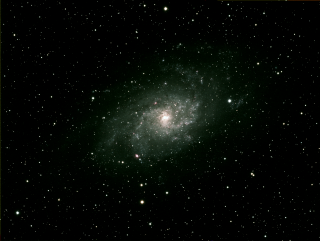 |
The following images where taken in the summer of 2010 in Munsonville (near Keene), New Hampshire (USA) using a Canon Digital Rebel XSi camera (unmodified, IR filter still present).
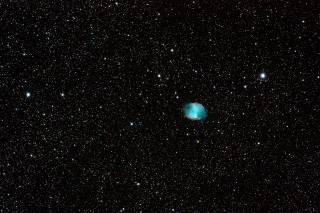 |
M27 (Dumbbell Nebula)
Type: Planetary nebula
Distance from earth: 1,360 light years
Constellation: Vulpecula
Brightness (magnitude): 7.5
This nebula is only a few thousand years old.
|
M31 (Andromeda Galaxy)
Type: Spiral galaxy
Distance from earth: 2.5 million light years
Constellation: Andromeda
Brightness (magnitude): 3.4
This galaxy is the closest spiral galaxy to our own. In the sky, its apparent size is three times the size of the moon. However, because it is not nearly as bright, one can only see a faint smudge in the sky with bare eyes. Its mass of about 700 billion solar masses is about the same as the mass of the Milky Way. Two other galaxies, M32 and M110 are also visible in this image.
|
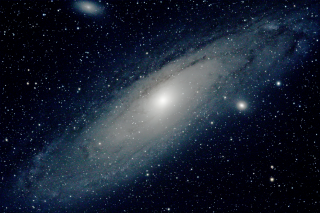 |
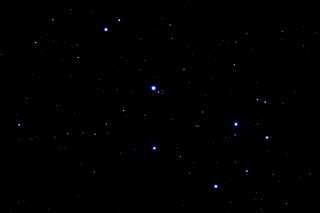 |
M45 (Pleiades, Seven Sisters)
Type: Open star cluster
Distance from earth: : 440 light years
Constellation: Taurus
Brightness (magnitude): 1.6
According to Greek mythology, the seven sisters (Maia, Electra, Taygete, Alcyone, Celaeno, Sterope and Merope) were transformed into birds by Zeus and placed them among the stars to comfort their father Atlas who had to carry the heavens, and to save them from Orion’s advances.
|
M51 (Whirlpool Galaxy)
Type: Spiral galaxy
Distance from earth: 23 million light years
Constellation: Canes Venatici
Brightness (magnitude): 8.4
These are two galaxies (M51a and M51b) that interact with each other.
|
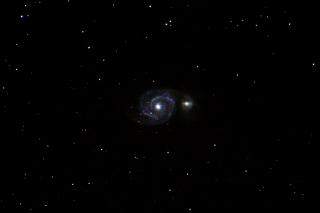 |
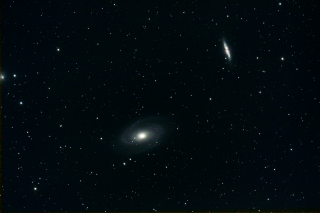 |
M81 (Bode’s Galaxy)
Type: Spiral galaxy
Distance from earth: : 12 million light years
Constellation: Ursa Major
Brightness (magnitude): 6.9
The black hole at its center has a mass of 70 million suns.
M82 (Cigar Galaxy)
Type: Starburst galaxy
Distance from earth: : 12 million light years
Constellation: Ursa Major
Brightness (magnitude): 8.4
Its center produces stars 10 faster than our galaxy.
|
M101 (Pinwheel Galaxy)
Type: Spiral galaxy
Distance from earth: 23 million light years
Constellation: Ursa Major
Brightness (magnitude): 7.9
This galaxy has a diameter of about 170,000 light years, almost twice the diameter of the Milky Way, and a mass of about 100 billion solar masses.
|
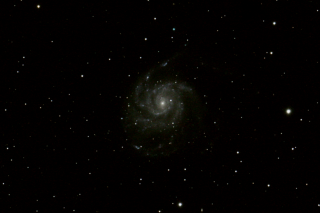 |
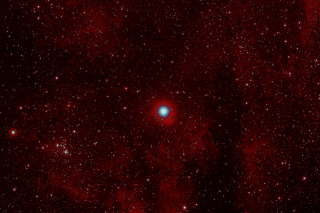 |
IC1318 (Sadr Region)
Type: Emission nebula
Distance from earth: : 3,700 light years
Constellation: Cygnus
Brightness (magnitude): 2.2
This nebula is in the Orion arm of our own galaxy. The bright star in the foreground in the center of the image is gamma Cygni.
|
IC5146 (Cocoon Nebula)
Type: Reflection/emission nebula
Distance from earth: 3,300 light years
Constellation: Cygnus
Brightness (magnitude): 7.2
Dark nebula Barnard 168 (B168) forms the dark arm extending from the nebula.
|
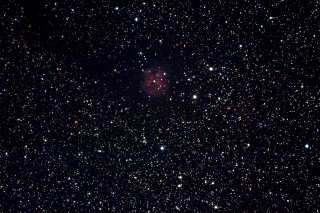 |
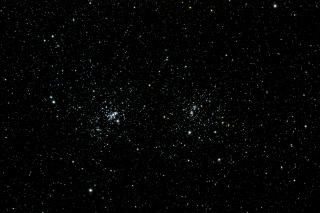 |
NGC869 & NGC884
Type: Open cluster
Distance from earth: : 7,600 light years
Constellation: Perseus
Brightness (magnitude): 5.3 & 6.1
The two clusters are only a few hundred light years apart.
|
Milky Way
Type: Spiral galaxy
Distance between earth and galaxy center: 25,000 light years
Our galaxy has between 100 billion and 400 billion stars and a diameter of about 100,000 light years. The NGC869 - NGC884 double cluster can be seen near the lower middle of the image, and the Andromeda galaxy (M31) in the upper right quadrant. The wide-field image was taken with the Canon camera biggybacked on the EQ-G mount and using the EF-S 18-55mm f/3.5-5.6 zoom lens.
|
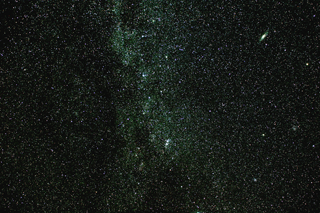 |
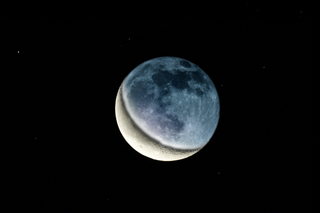 |
Earth's Moon
Type: Moon
Distance from earth: ~385,000 km
Mass: 0.0123 earth masses
This image is a montage of a short and long exposure of the waning moon on August 6th.
|




